最新七年级英语一般现在时
- 格式:pdf
- 大小:18.96 KB
- 文档页数:3
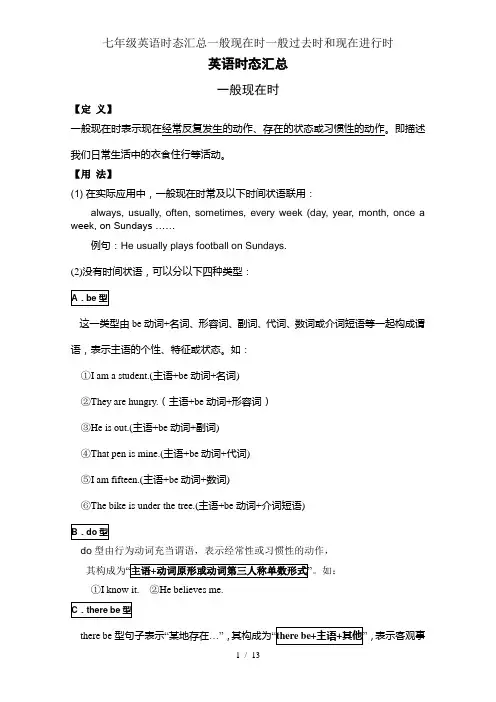
英语时态汇总一般现在时【定义】一般现在时表示现在经常反复发生的动作、存在的状态或习惯性的动作。
即描述我们日常生活中的衣食住行等活动。
【用法】(1) 在实际应用中,一般现在时常及以下时间状语联用:always, usually, often, sometimes, every week (day, year, month, once a week, on Sundays ……例句:He usually plays football on Sundays.(2)没有时间状语,可以分以下四种类型:这一类型由be动词+名词、形容词、副词、代词、数词或介词短语等一起构成谓语,表示主语的个性、特征或状态。
如:①I am a student.(主语+be动词+名词)②They are hungry.(主语+be动词+形容词)③He is out.(主语+be动词+副词)④That pen is mine.(主语+be动词+代词)⑤I am fifteen.(主语+be动词+数词)⑥The bike is under the tree.(主语+be动词+介词短语)do型由行为动词充当谓语,表示经常性或习惯性的动作,其构成为。
如:①I know it. ②He believes me.there be型句子表示“某地存在…”,其构成为,表示客观事实。
用法遵循,即主语是单数或并列主语中的第一个主语是单数,则用there is;主语是复数或并列主语中的第一个主语是复数,则用there are。
如:(1)There is an eraser on the teacher's desk.(主语an eraser是单数)(2)There is an orange,five apples and eight bananas in the bag.(并列主语中的第一个主语an orange是单数)情态动词型句子的构成为,情态动词和动词原形一起构成谓语,表示说话人对所叙述的动作或状态的看法。

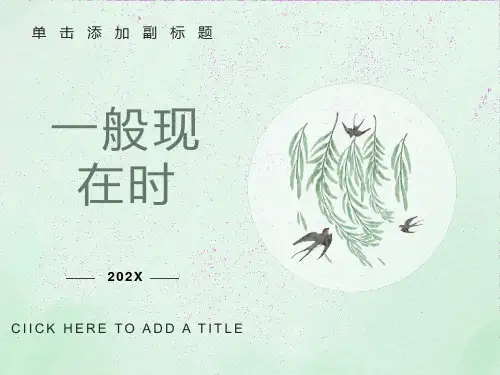
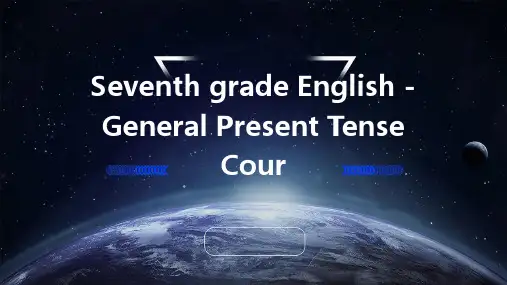
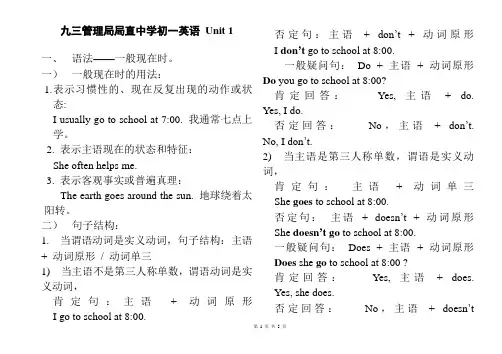
九三管理局局直中学初一英语Unit 1一、语法——一般现在时。
一)一般现在时的用法:1.表示习惯性的、现在反复出现的动作或状态:I usually go to school at 7:00. 我通常七点上学。
2. 表示主语现在的状态和特征:She often helps me.3. 表示客观事实或普遍真理:The earth goes around the sun. 地球绕着太阳转。
二)句子结构:1. 当谓语动词是实义动词,句子结构:主语+ 动词原形/ 动词单三1) 当主语不是第三人称单数,谓语动词是实义动词,肯定句:主语+ 动词原形I go to school at 8:00.否定句:主语+ don’t+ 动词原形I don’t go to school at 8:00.一般疑问句:Do + 主语+ 动词原形Do you go to school at 8:00?肯定回答:Yes, 主语+ do. Yes, I do.否定回答:No,主语+ don’t. No, I don’t.2) 当主语是第三人称单数,谓语是实义动词,肯定句:主语+ 动词单三She goes to school at 8:00.否定句:主语+ doesn’t + 动词原形She doesn’t go to school at 8:00.一般疑问句:Does + 主语+ 动词原形Does she go to school at 8:00 ?肯定回答:Yes, 主语+ does.Yes, she does.否定回答:No,主语+ doesn’tNo, she doesn’t.3)动词第三人称单数的变化规则:a. 一般情况下,在词尾加-s:play- plays get- gets.b. 以s,x,sh,ch结尾的动词,在词尾加-es:watch- watches go- goes.c. 以辅音字母加y结尾的动词,要把y变成i,再加-es:fly- flies study- studies2. 当谓语动词是be动词,句子结构:主语+ be 的适当形式1) 肯定句:主语+ be (am / is are)I am an English teacher.否定句:主语+ be (m / is are)+ notI am not an English teacher.一般疑问句:Be(Is/ Are) + 主语Are you an English teacher?肯定回答:Yes, 主语+ be(am/ is/ are). Yes, I am.否定回答:No,主语+ don’t. No, I am not.2)be动词的使用口诀:我用am,你用are,is连着他她塔,单数is 复数are。

一般现在时详解一、定义:表示现在经常性或习惯性的动作或状态;表示客观真理、科学事实、格言以及不受时间限制的客观存在。
口诀:动词一般现在时,表示真理或习惯,三单人称做主语,动词加上s/es。
二、时间状语:句子中出现下列时间状语,用一般现在时often(经常), usually(通常), sometimes(有时),always(总是), once a week(一周一次),every day/week(每天/周), never(从不), on/at weekend(在周末),seldom(很少)三、含有be动词的一般现在时口诀:I和am,you和are,he she it(人名、地名、事物名)跟着is,单数is,复数are,变否定,be后not,变疑问,be提前(句首)。
注意:1表示单数的人名、地名、事物名,通常看做是第三人称单数。
例如Lily(人名),Beijing (地名),a book(事物名)2含有be动词的肯定句变疑问句A,把第一人称改为第二人称,即I变you,we变you,my变your。
B,be动词放在句首,其余照抄。
例如I am a girl. She is a doctor.否定句:I am not a girl. She is not a doctor.疑问句:Are you a girl? Is she doctor? (No, I’m not的回答: Yes, I am. Yes, she is. 回答和其余的回No, I’m not. No, she is n’t 答不一样)四、含有实义动词的一般现在时。
1,动词的第三人称单数形式口诀:动词三单现在式,一般词尾加s,s, x, sh, ch, o结尾,直接加上es,辅音字母加y尾,变y为i加es。
例如:have---has(特例) go---goes pass---passes watch---watches try---tries 2, 含有实义动词的一般现在时口诀:主语为非三单变肯定,动词用原形,(主语不是第三人称单数)变否定,动词前加don’t,变疑问,句首加do。
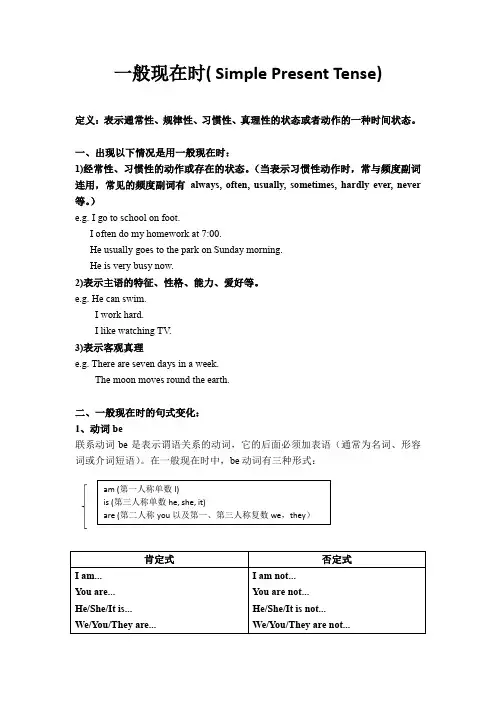
一般现在时( Simple Present Tense)定义:表示通常性、规律性、习惯性、真理性的状态或者动作的一种时间状态。
一、出现以下情况是用一般现在时:1)经常性、习惯性的动作或存在的状态。
(当表示习惯性动作时,常与频度副词连用,常见的频度副词有 always, often, usually, sometimes, hardly ever, never 等。
)e.g. I go to school on foot. I often do my homework at 7:00.He usually goes to the park on Sunday morning. He is very busy now.2)表示主语的特征、性格、能力、爱好等。
e.g. He can swim.I work hard. I like watching TV . 3)表示客观真理e.g. There are seven days in a week.The moon moves round the earth.二、一般现在时的句式变化: 1、动词be联系动词be 是表示谓语关系的动词,它的后面必须加表语(通常为名词、形容词或介词短语)。
在一般现在时中,be 动词有三种形式:一、用be的适当形式填空1.---How____ you? ---I____ fine.2.I___ David,and my family name___ Green.3.---What color ___ your clock? ---It___ white.4.---What___ this in English?---It___ an apple.5.Toy___my brother.David____my brother,too.They ___ my brothers.6.Look!These____apple trees.7.We____ good students and you____ good teacher.8.My sister and my brother_____ students.9. _____there many eggs in the kitchen?10.____your card number 5578?11.Where_____ your pencils?12.These sweaters ______ fifty dollars.13.How much ____ his jacket?14.My brother’s birthday____ December 11th.15.When _____ Kate’s birthday?16、There_____a boy and two girls beside the gate.17、Five and three ____ eight.二、.将下面的句子变成一般疑问句。
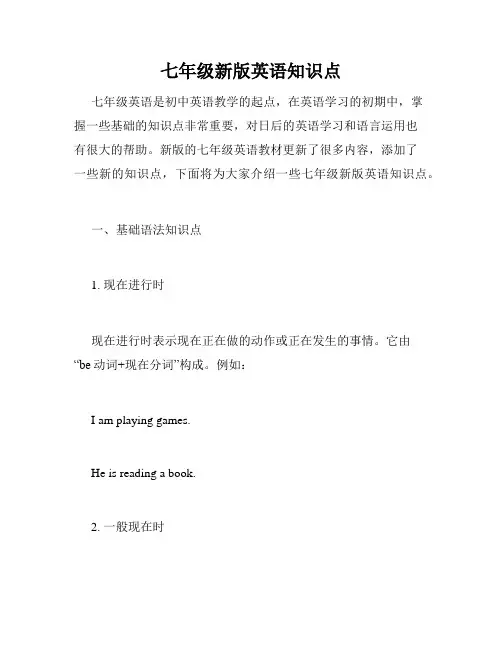
七年级新版英语知识点七年级英语是初中英语教学的起点,在英语学习的初期中,掌握一些基础的知识点非常重要,对日后的英语学习和语言运用也有很大的帮助。
新版的七年级英语教材更新了很多内容,添加了一些新的知识点,下面将为大家介绍一些七年级新版英语知识点。
一、基础语法知识点1. 现在进行时现在进行时表示现在正在做的动作或正在发生的事情。
它由“be动词+现在分词”构成。
例如:I am playing games.He is reading a book.2. 一般现在时一般现在时表示现在经常或习惯性地发生的事情,或者客观事实。
它的构成是主语+动词原形+s/es。
例如:I eat breakfast at 7:00 am.She enjoys playing the piano.3. 一般过去时一般过去时表示过去的某个时间或一段时间内发生的事情,它由动词的过去式构成。
例如:I watched a movie last night.He walked to school every day last year.二、常用单词和短语1. 颜色red, blue, green, yellow, black, white, purple, pink, gray 2. 数字one, two, three, four, five, six, seven, eight, nine, ten 3. 表示时间hour, minute, second, morning, afternoon, evening, night 4. 表示家庭father, mother, brother, sister, grandfather, grandmother 5. 表示身体部位head, shoulder, arm, hand, leg, foot三、常用句型和表达方式1. 问候语Hello! / Hi!How are you?2. 提出请求Could you please...? / Would you mind...? Can you...?3. 表示喜欢或不喜欢I like... / I love...I don't like... / I hate...4. 询问和回答问题What's your name?How old are you?Where do you live?五、学习方法和注意事项学习英语需要坚持,不能三天打鱼两天晒网。
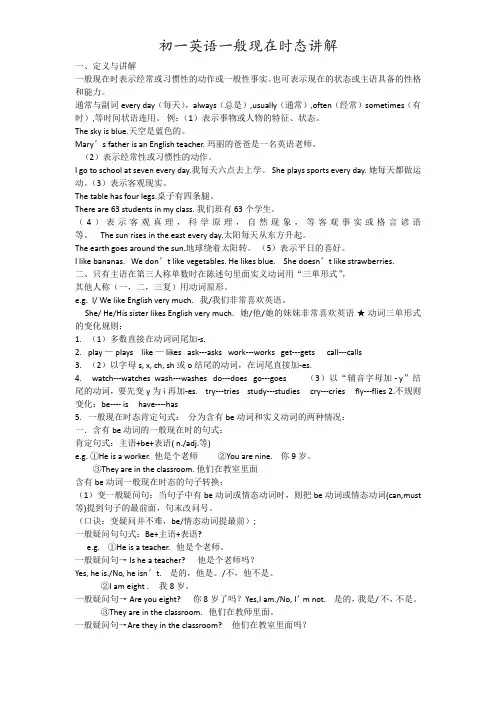
一、定义与讲解一般现在时表示经常或习惯性的动作或一般性事实。
也可表示现在的状态或主语具备的性格和能力。
通常与副词every day(每天),always(总是),usually(通常),often(经常)sometimes(有时),等时间状语连用。
例:(1)表示事物或人物的特征、状态。
The sky is blue.天空是蓝色的。
Mary’s father is an English teacher.玛丽的爸爸是一名英语老师。
(2)表示经常性或习惯性的动作。
I go to school at seven every day.我每天六点去上学。
She plays sports every day.她每天都做运动。
(3)表示客观现实。
The table has four legs.桌子有四条腿。
There are63students in my class.我们班有63个学生。
(4)表示客观真理,科学原理,自然现象,等客观事实或格言谚语等。
The sun rises in the east every day.太阳每天从东方升起。
The earth goes around the sun.地球绕着太阳转。
(5)表示平日的喜好。
I like bananas.We don’t like vegetables.He likes blue.She doesn’t like strawberries.二、只有主语在第三人称单数时在陈述句里面实义动词用“三单形式”,其他人称(一,二,三复)用动词原形。
e.g.I/We like English very much.我/我们非常喜欢英语。
She/He/His sister likes English very much.她/他/她的妹妹非常喜欢英语★动词三单形式的变化规则:1.(1)多数直接在动词词尾加-s.2.play—plays like—likes ask---asks work---works get---gets call---calls3.(2)以字母s,x,ch,sh或o结尾的动词,在词尾直接加-es.4.watch---watches wash---washes do---does go---goes(3)以“辅音字母加 - y”结尾的动词,要先变y为i再加-es.try---tries study---studies cry---cries fly---flies2.不规则变化:be---- is have----has5.一般现在时态肯定句式:分为含有be动词和实义动词的两种情况:一.含有be动词的一般现在时的句式:肯定句式:主语+be+表语(n./adj.等)e.g.①He is a worker.他是个老师②You are nine.你9岁。
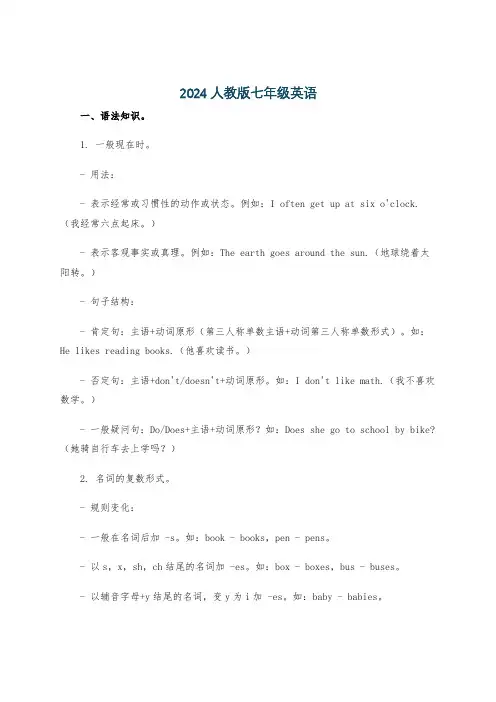
2024人教版七年级英语一、语法知识。
1. 一般现在时。
- 用法:- 表示经常或习惯性的动作或状态。
例如:I often get up at six o'clock.(我经常六点起床。
)- 表示客观事实或真理。
例如:The earth goes around the sun.(地球绕着太阳转。
)- 句子结构:- 肯定句:主语+动词原形(第三人称单数主语+动词第三人称单数形式)。
如:He likes reading books.(他喜欢读书。
)- 否定句:主语+don't/doesn't+动词原形。
如:I don't like math.(我不喜欢数学。
)- 一般疑问句:Do/Does+主语+动词原形?如:Does she go to school by bike?(她骑自行车去上学吗?)2. 名词的复数形式。
- 规则变化:- 一般在名词后加 -s。
如:book - books,pen - pens。
- 以s,x,sh,ch结尾的名词加 -es。
如:box - boxes,bus - buses。
- 以辅音字母+y结尾的名词,变y为i加 -es。
如:baby - babies。
- 以o结尾的名词,有生命的加 -es(如:potato - potatoes,tomato - tomatoes),无生命的加 -s(如:photo - photos)。
- 不规则变化:- 例如:man - men,woman - women,child - children,foot - feet,tooth - teeth等。
3. 形容词性物主代词。
- 包括:my(我的),your(你的/你们的),his(他的),her(她的),its (它的),our(我们的),their(他们的)。
- 用法:用来修饰名词,表示所属关系。
例如:This is my book.(这是我的书。
)二、词汇积累。
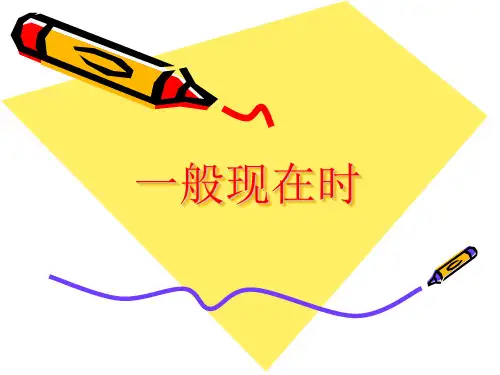
人教版七年级英语时态总结人教版七年级英语时态总结如下:1、一般现在时(1)构成:主语+be动词(am/is/are)+其他。
(2)用法:表示现在经常发生的动作或存在的状态。
例句:He is a student. 他是一个学生。
2、现在进行时(1)构成:主语+be动词(am/is/are)+动词-ing形式。
(2)用法:表示现在正在进行的动作或存在的状态。
例句:He is listening to the music now.他现在正在听音乐。
3、现在完成时(1)构成:主语+have/has+动词的过去分词。
(2)用法:表示过去发生的动作对现在造成的影响或结果。
例句:I bought a new house, but I haven't sold my old one yet, so at the moment I have two houses.我买了一所新房子,但是还没有卖掉旧的,所以现在我又两所房子。
4、现在完成进行时(1)构成:主语+have/has+been+动词的ing形式。
(2)用法:表示从过去某一时刻开始一直延续到现在的动作或状态,强调这个动作可能会继续下去。
例句:We have been working on this project for over a month now.到目前为止,我们一直在处理那个项目,已经花了一个多月时间了。
5、一般过去时(1)构成:主语+动词的过去式。
(2)用法:表示过去某个时间发生的动作或存在的状态。
例句:I bought some fruits yesterday.我昨天买了一些水果。
6、过去进行时(1)构成:主语+was/were+动词-ing形式。
(2)用法:表示过去某个时间正在进行的动作或存在的状态。
例句:I was travelling in London last summer vacation.去年暑假我在伦敦旅行。
7、过去完成时(1)构成:主语+had+动词的过去分词。
七年级英语重点语法:一般现在时1.一般现在时的用法①表示经常性、习惯性的动作或存在的状态。
常与频度副词连用。
I often take a walk in the park. 我经常在公园散步。
These T-shirts are new. 这些T恤衫是新的。
①表示客观事实、真理。
The sun rises in the east and sets in the west. 太阳东升西落。
①在时间、条件状语从句中表示将来的动作。
If it doesn’t rain tomorrow, I will go bike riding in the open air. 如果明天不下雨,我将在户外骑自行车。
I’ll tell her the good news when she comes back. 当她回来的时候,我将把这个好消息告诉她。
①表示按计划或安排将要发生的动作,可用一般现在时表将来。
但只限于start,begin,leave,go,come,arrive,return,take place等。
2.一般现在时的构成语法知识精练题型一:“三单”形式的变化规则1.—What happens when water freezes?—It ________ into ice.A.turns B.will turn C.turned D.has turned2.Tom ________ to school by bike every morning.A.go B.went C.is going D.goes3.The boy never ________ his teeth before bedtime. His parents are very angry.A.brush B.brushes C.brushed D.brushing4.The earth is a planet (行星) and it ________ around the sun.A.goes B.go C.will go D.went5.Mr. Green has two dogs. He ____________ them every morning.A.walked B.will walk C.walks D.is walking6.Amy usually ________ sports on Sunday mornings.A.is having B.has C.has had D.was having7.Tony usually ________ to school on time, but this morning he ________ late.A.gets; arrives B.got; arrived C.gets; arrived D.got; arrives8.She usually ________ to music in the evening, but now she ________ TV.A.listens; watches B.is listening; watchesC.listens; is watching D.is listening; is watching9.Mike usually _______ up at six thirty in the morning, but he _______ up at seven this morning. He was late for school.A.got; got B.got; gets C.gets; gets D.gets; got10.Linda _________ a twin brother, and she is _________ than him.A.is; taller B.has; tall C.has; taller D.have; taller11.It often _________ here in winter. Look! It’s _________ again.A.snows; snowing B.snowy; snowingC.snows; snows D.snowing; snows12._______ his sister, he also ________ running.A.Like; like B.Likes; likes C.Like; likes D.Likes; like13.Tommy always ________ to keep healthy. Look! He ________ in the pool now.A.swims; swims B.swims; is swimmingC.is swimming; is swimming D.is swimming; swims14.Bob ________ basketball and he looks ________ his father.A.likes, like B.like, likes C.likes, likes D.like, like15.—Does Ella like ________?—Yes. She often ________ things from the stores.A.shop; buys B.shop; is buyingC.shopping; buys D.shopping; is buying16.It often _________ heavily in summer. We have to wear raincoats when we go out.A.rains B.rain C.snows D.snow17.It often ______ in South China.A.snow B.snows C.rainy D.rains18.Jane sometimes ________ around the city with her parents on weekends.A.travel B.travelsC.traveled D.will travel19.When ice melts, it ________ into water.A.turns B.will turn C.turned D.is turning20.Mike ________ of medium height and he ________ short hair.A.is, is B.are, have C.has, has D.is, has题型二:表示经常性动作/状态21.I ______ basketball on the playground with my friends every Saturday.A.play B.will play C.played D.am playing22.Every year, the Vienna New Year’s Concert ________ place on 1st January.A.takes B.is taking C.took D.will take23.Tom usually ______ his bike to school but he ______ the subway there this morning.A.rides; took B.rides; takes C.ride; took D.rode; took24.Chinese people often ________ when they meet visitors.A.smile B.smiled C.are smiling D.will smile25.—Steve, what do you often do after school?—I often ________ basketball with my friends.A.play B.played C.will play D.am playing26.Susan lives far from school. She usually ________ a bus to school.A.has taken B.took C.takes D.will take27.—Listen! Someone ________ in the next room.—It must be Lily. She ________ singing every afternoon.A.sings; practices B.sings; practicing C.is singing; practices D.is singing; is practicing 28.—It ________ heavily last night. So there is snow on the ground everywhere today.—Yes. It often ________ here in winter.A.snowed; snows B.snowed; is snowing C.snows; is snowing D.snows; snows 29.Jim often ________ for a walk after dinner. But yesterday he ________.A.go; doesn’t B.goes; didn’t C.went; didn’t D.went; doesn’t 30.He often _________ French after _________ his homework every day.A.study; finish B.studied; finished C.studies; finishing D.studying; finishing题型三:表示现在的能力/特征31.—Does Alice like oranges?—No, she doesn’t. She ________ apples.A.like B.liking C.liked D.likes32.The store _______ T-shirts in all colors and they’re on _______.A.sell; sale B.sale; sell C.sells; sale D.sales; sell33.My brother _______ the piano very well, but he doesn’t have time to play now.A.will play B.is playing C.played D.plays34.Many years ago, I ________ to be a doctor. But now ________ a worker.A.wanted; I was B.wanted; I’mC.want; I’m D.want; I was35.My sister ________ walk a year ago, but now she ________.A.couldn’t; could B.couldn’t; can C.can; can D.could; could题型四:表示事实或客观真理36.—Where ________ he from?—He is from the United States.A.was B.are C.am D.is37.Allen used _________ to school, but now he _________ to school by bus.A.walking; goes B.walking; is going C.to walk; goes D.to walk; going 38.One of my friends ________ a pet dog. The dog’s name is Duoduo.A.have B.has C.to have D.having39.— We ________ very simply and do not spend much money on food.— That’s why you’re called the Greens.A.eat B.ate C.will eat D.had eaten40.— Look at the sign there! It ________ “No fishing!”— Sorry, I __________ notice it.A.said; don’t B.said; didn’t C.says; didn’t D.says; don’t 41.—Let’s buy some ________ for our school trip.—That ________ good.A.strawberry; sound B.salad; sounds C.hamburger; sounds D.pear; sound42.I ________ a red book. She ________ two red books.A.have; has B.has; have C.have; have D.has; has43.As we all know, light ________ a lot faster than sound.A.travels B.travelled C.is travelling D.to travel44.One of his best friends ________ the US.A.come from B.is from C.are from D.are coming from 45.His mother ________ in a hospital, but she ________ there these days.A.works; isn’t workingB.is working; worksC.is work; doesn’t workD.works; not works题型五:表示现在发生的具体动作46.—What club does he join?—He can _________ pictures, so he ________ the art club.A.draw; join B.draws; joins C.draws; join D.draw; joins 47.—Great news! The land (着陆) of The Shenzhou XIII is a great success!—It ________ me excited and ________ proud to be a Chinese.A.make; feel B.made; to feel C.makes; feel D.makes; feeling 48.I at the picture now. I some koalas in it.A.am looking; see B.look; seeingC.am looking; am seeing D.look; see49.—The phone is ringing, Sam.— I _______, but I’m busy. Could you answer it, please?A.know B.knowing C.am knowing D.knew 50.Mike _________ the earphones on the sofa a moment ago, but now they _________ there. A.put; weren’t B.put; aren’tC.putted; are D.puts; are参考答案:1.A【详解】句意:——当水冻结时会发生什么?——它会变成冰。